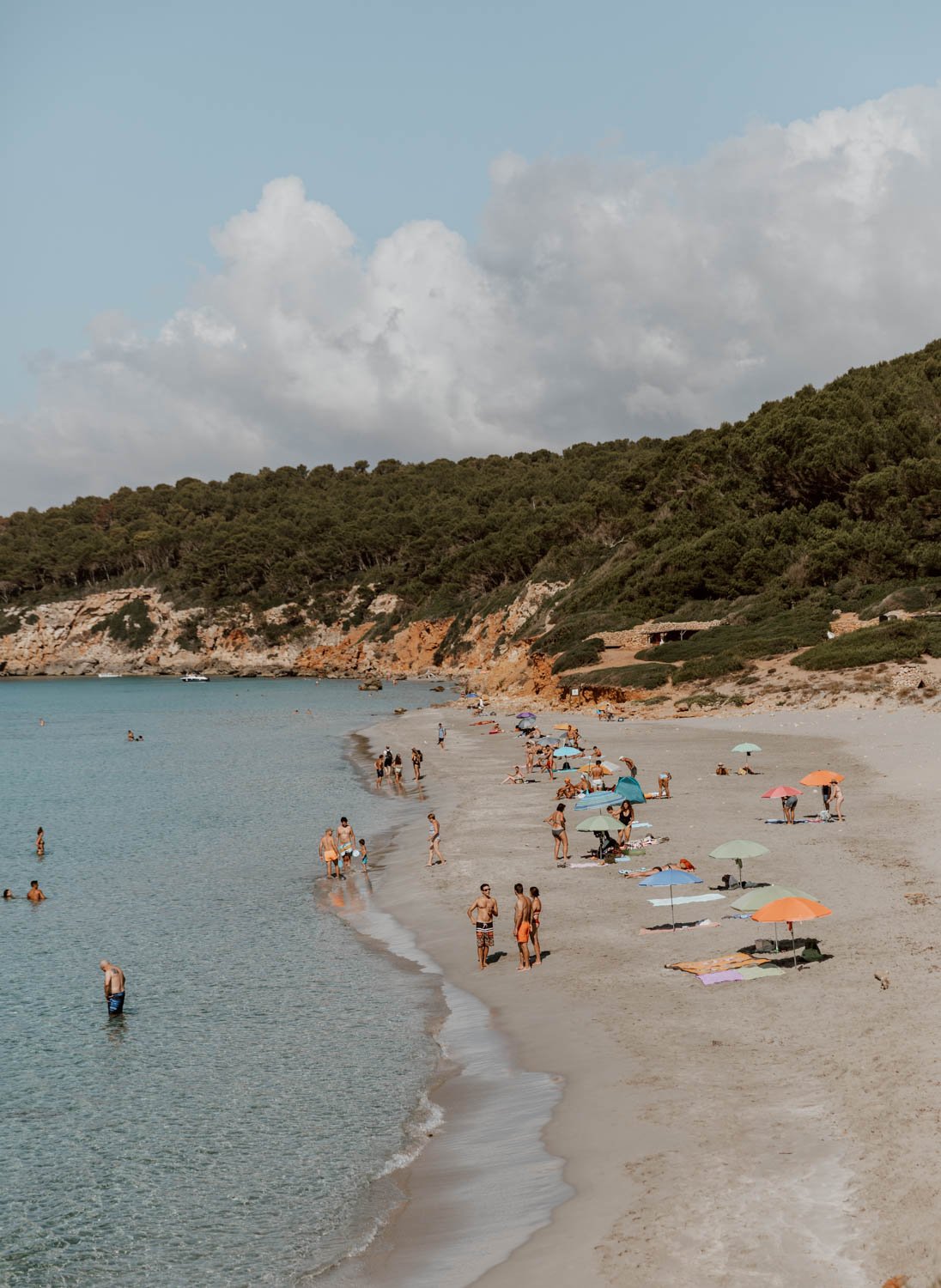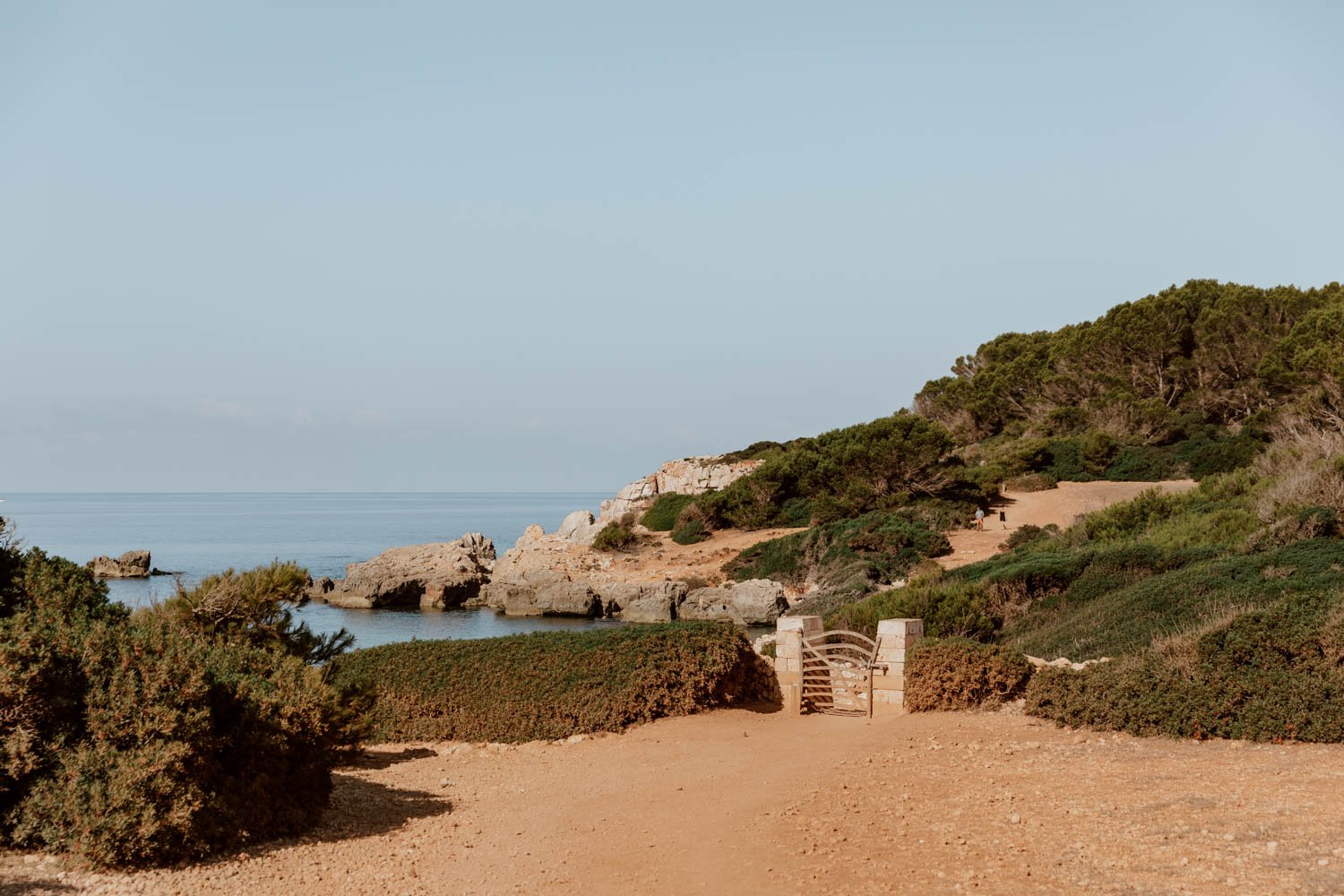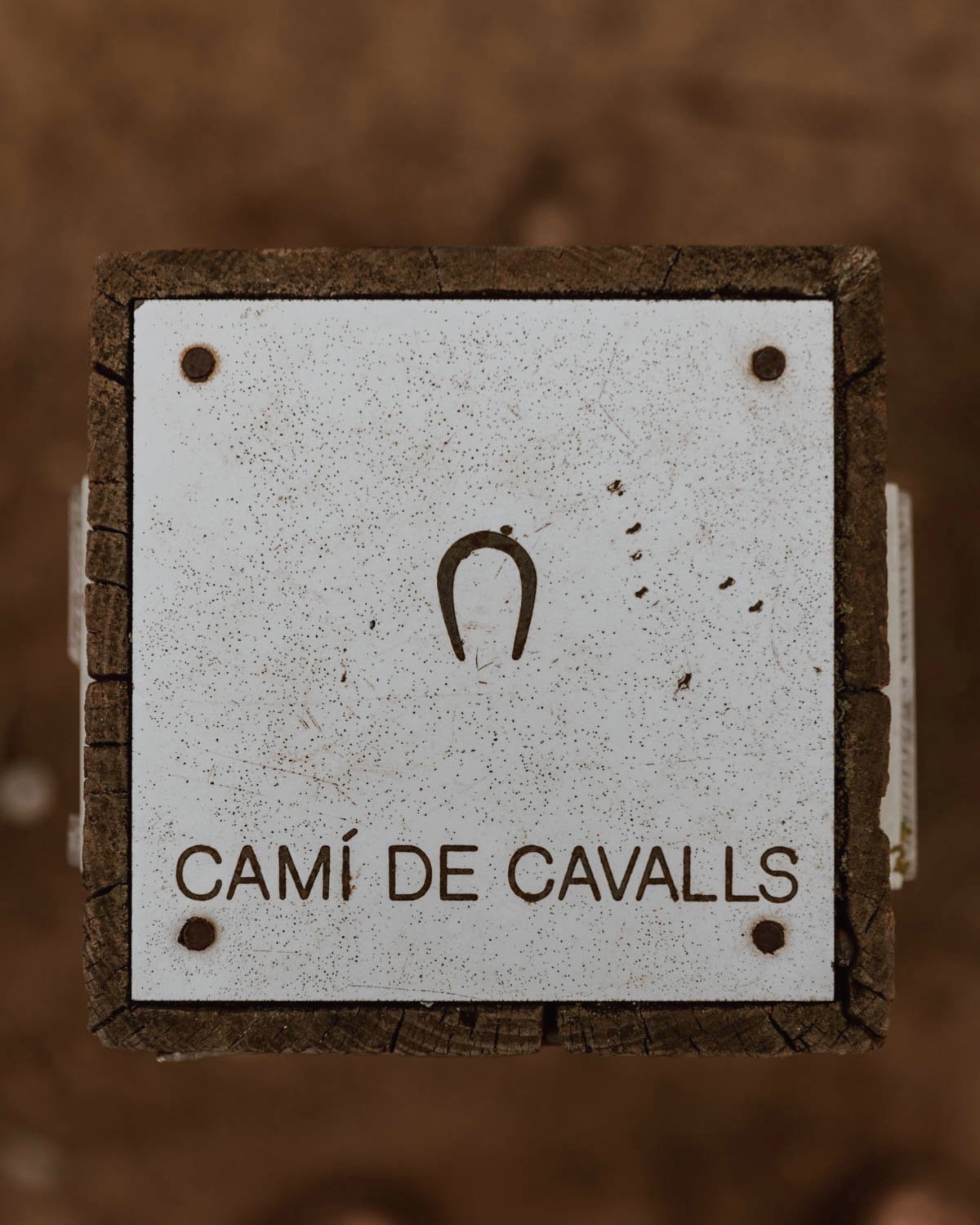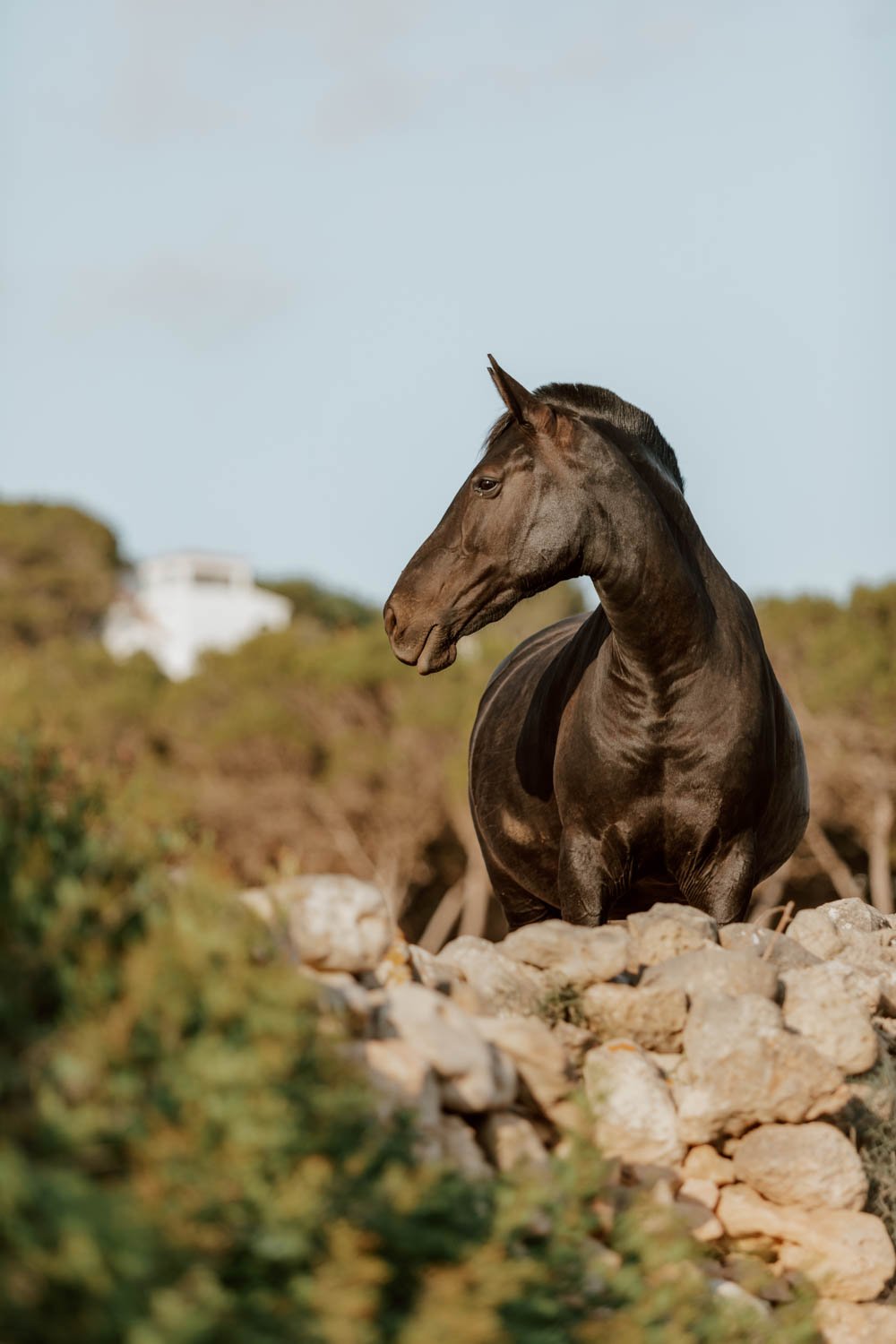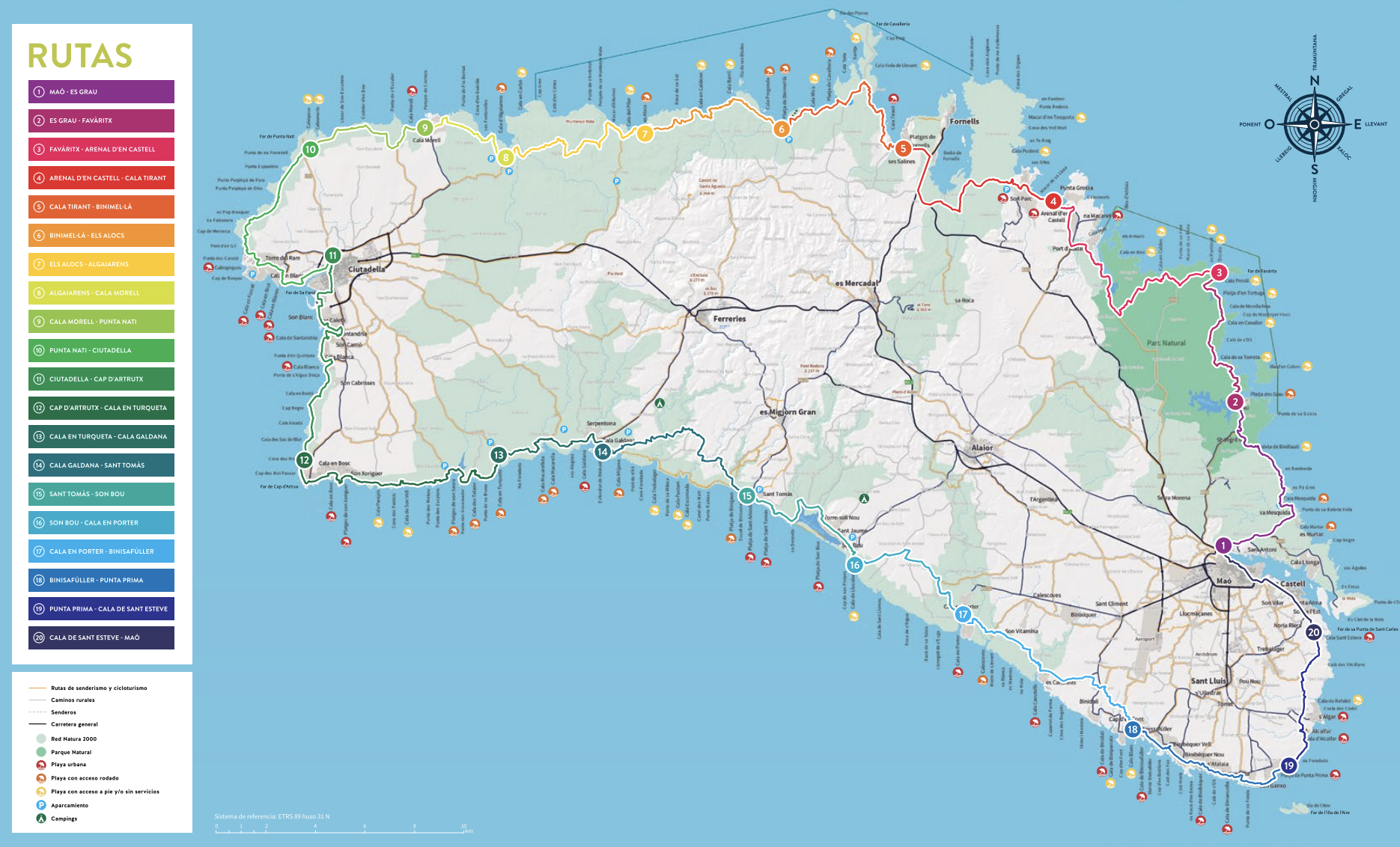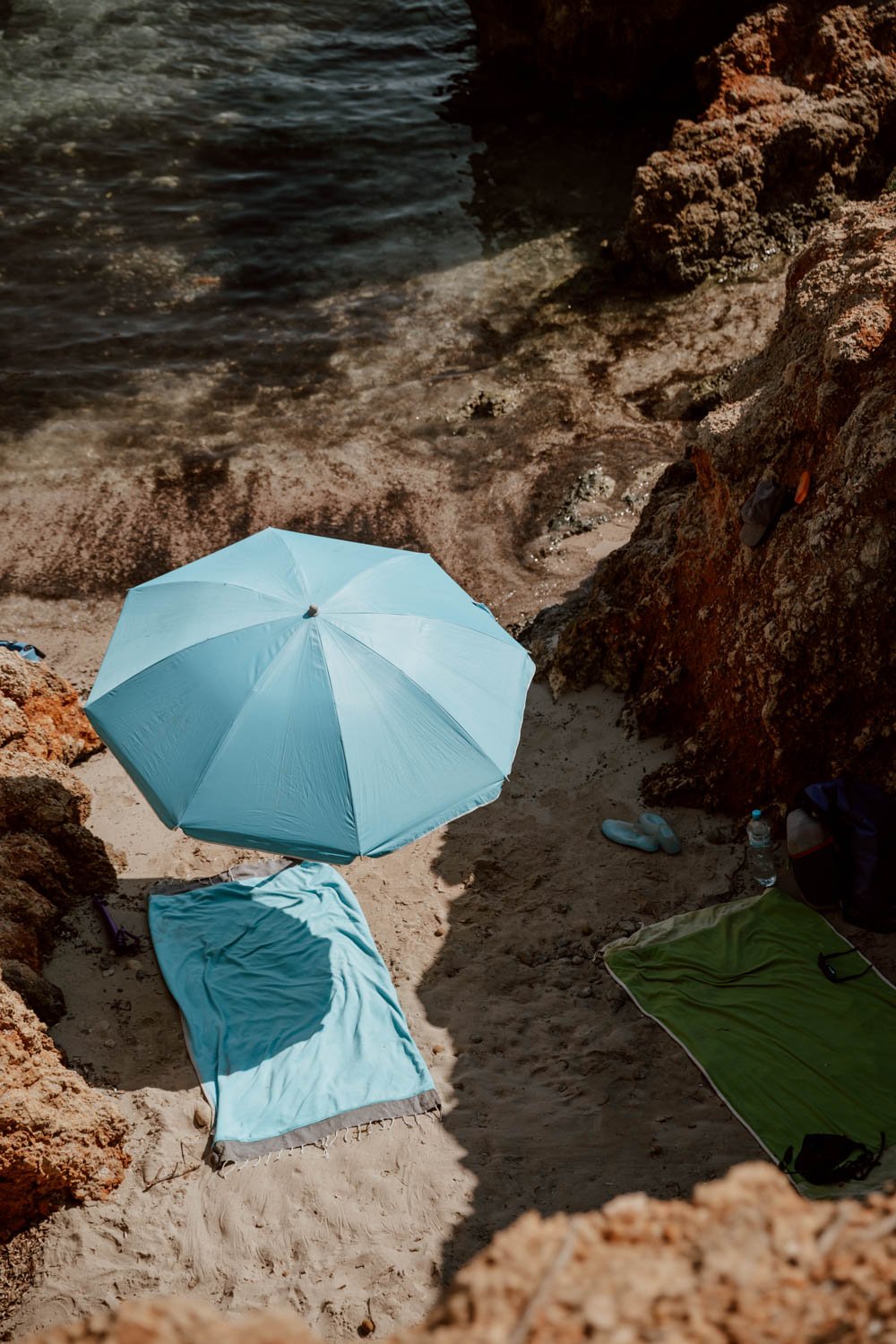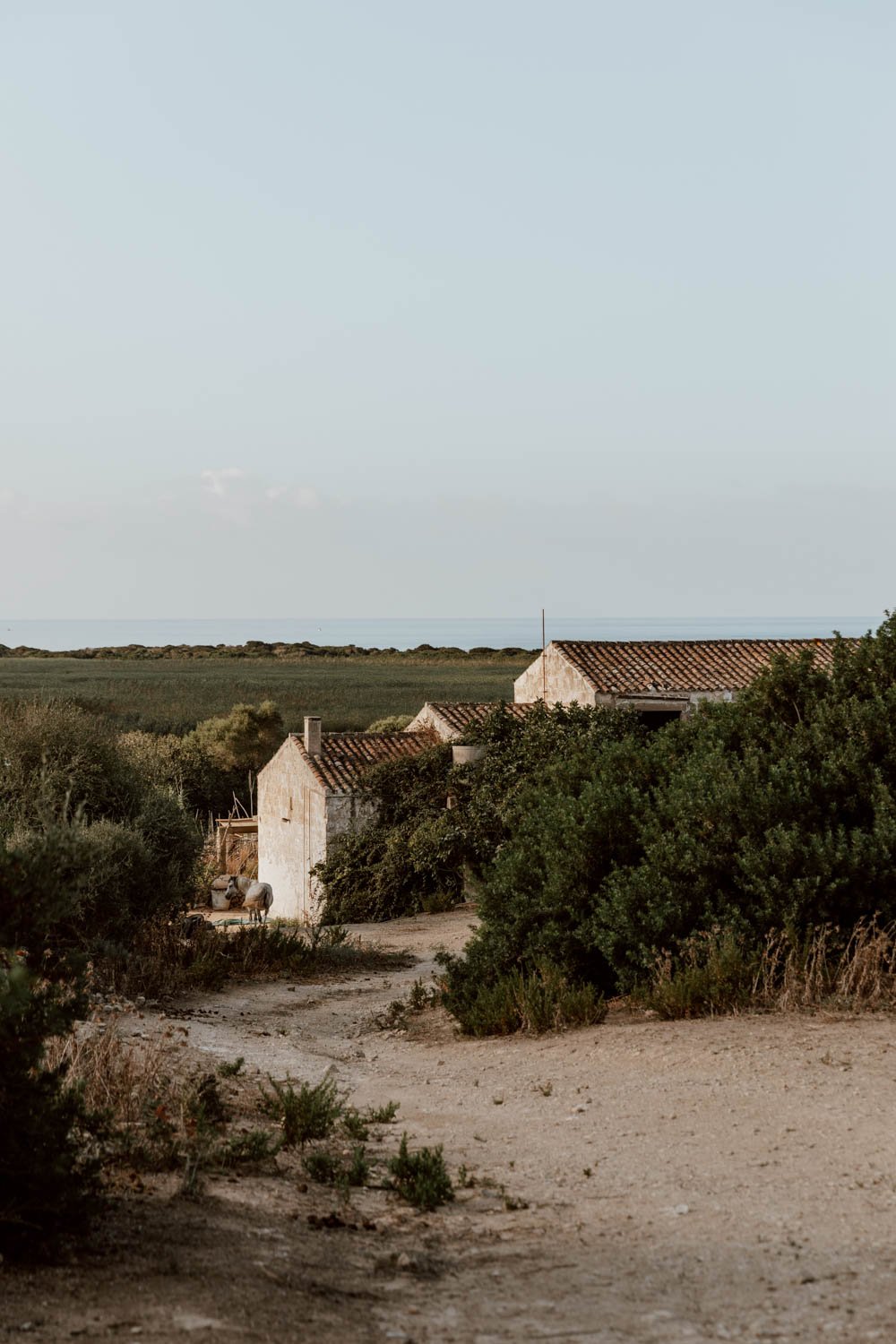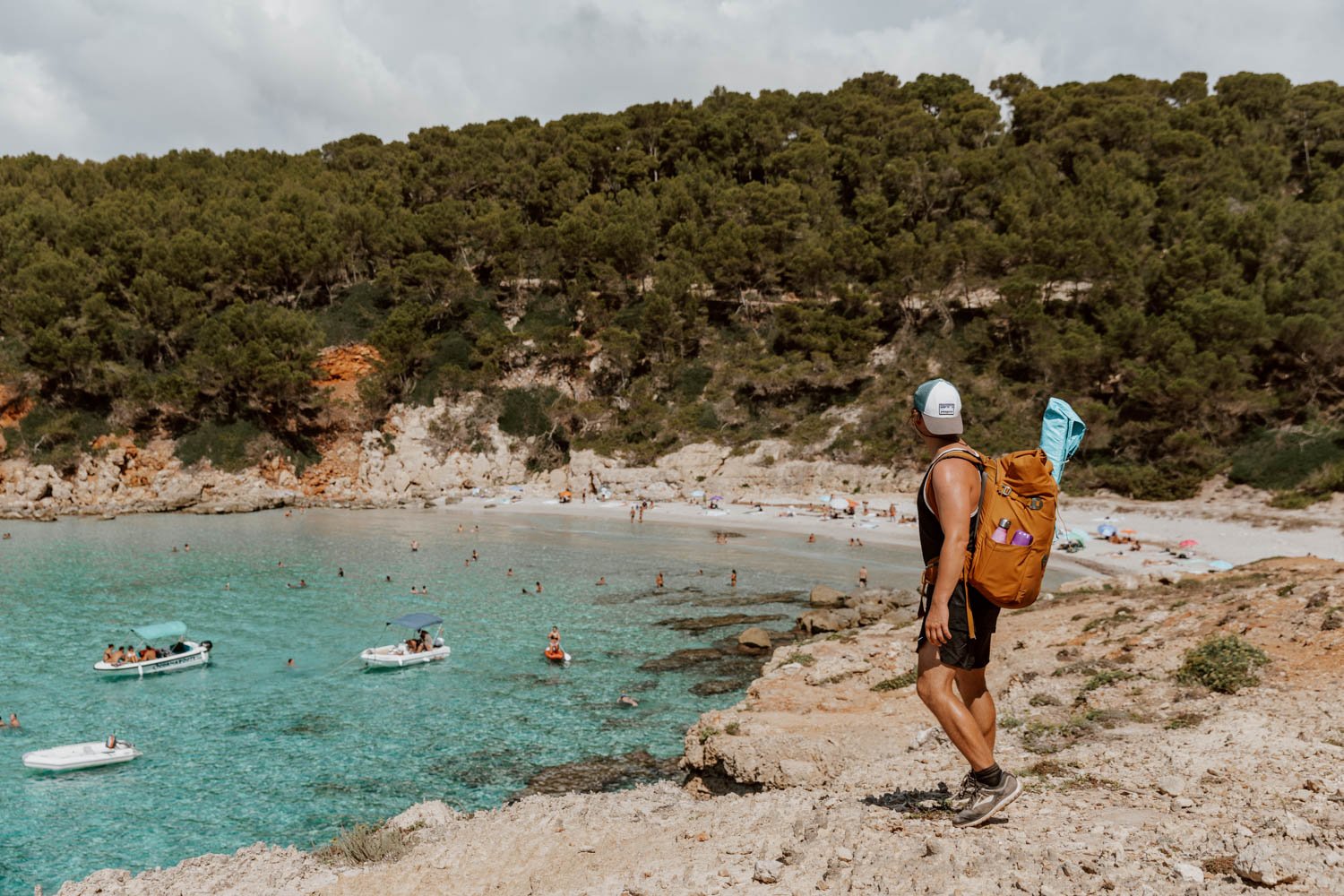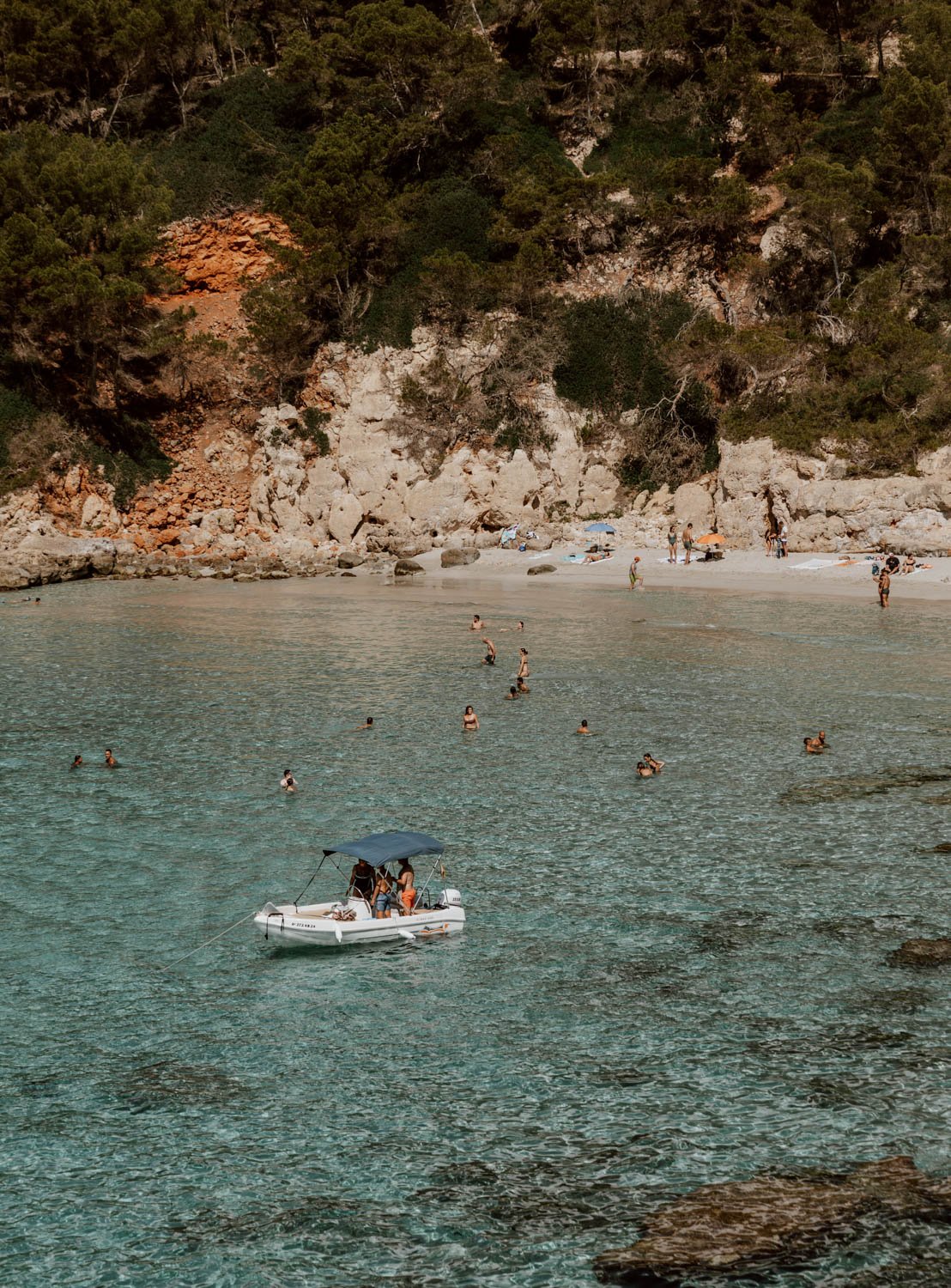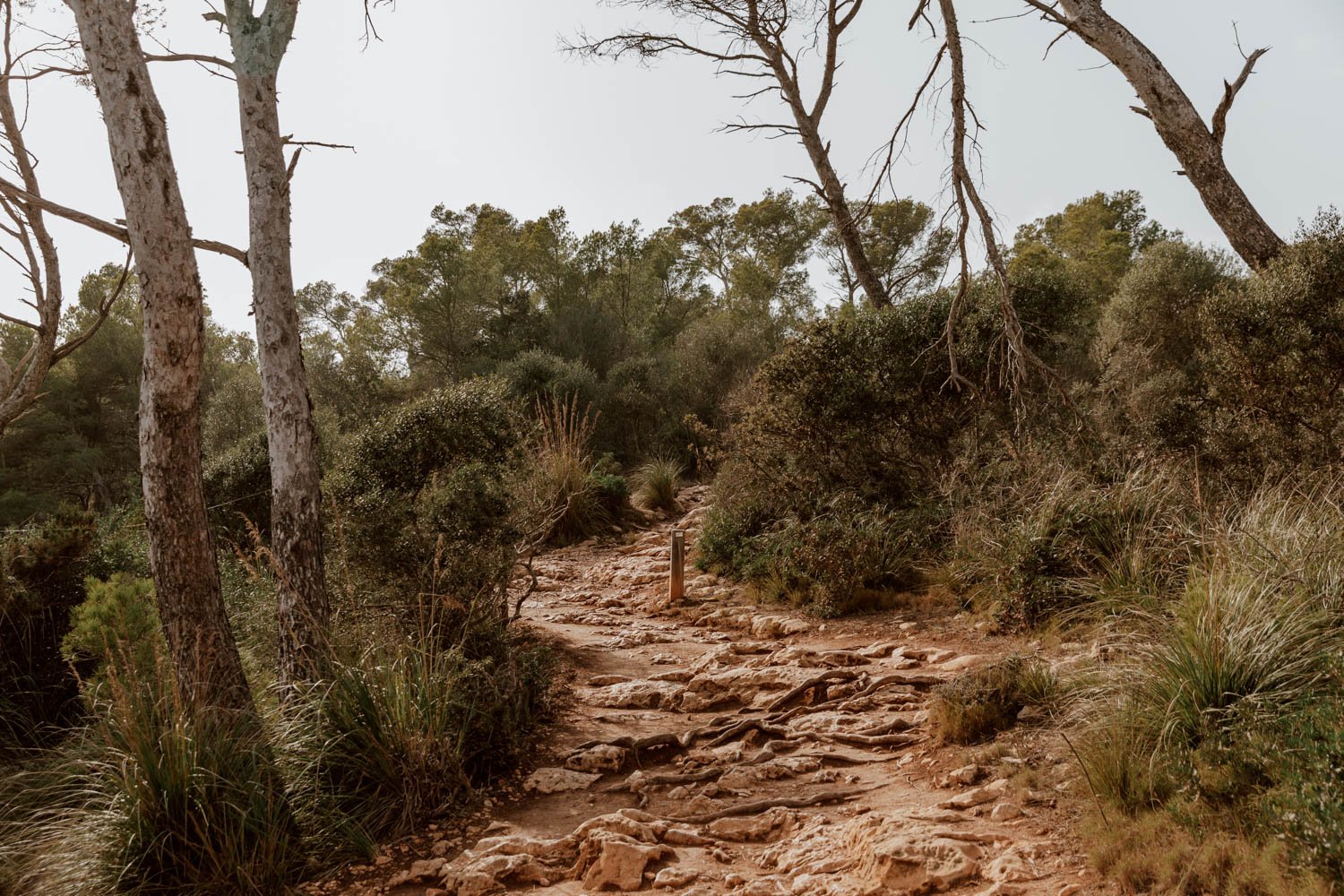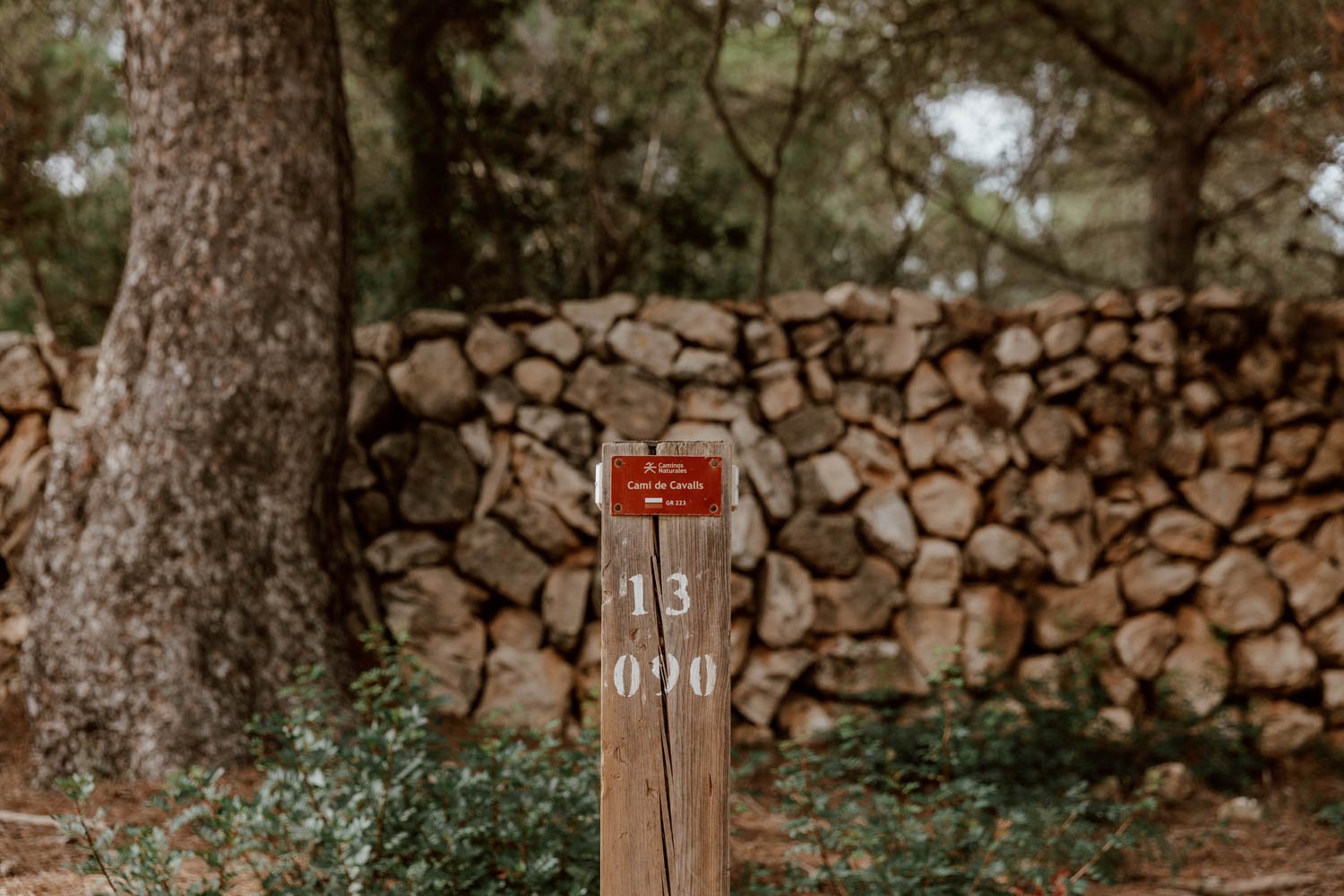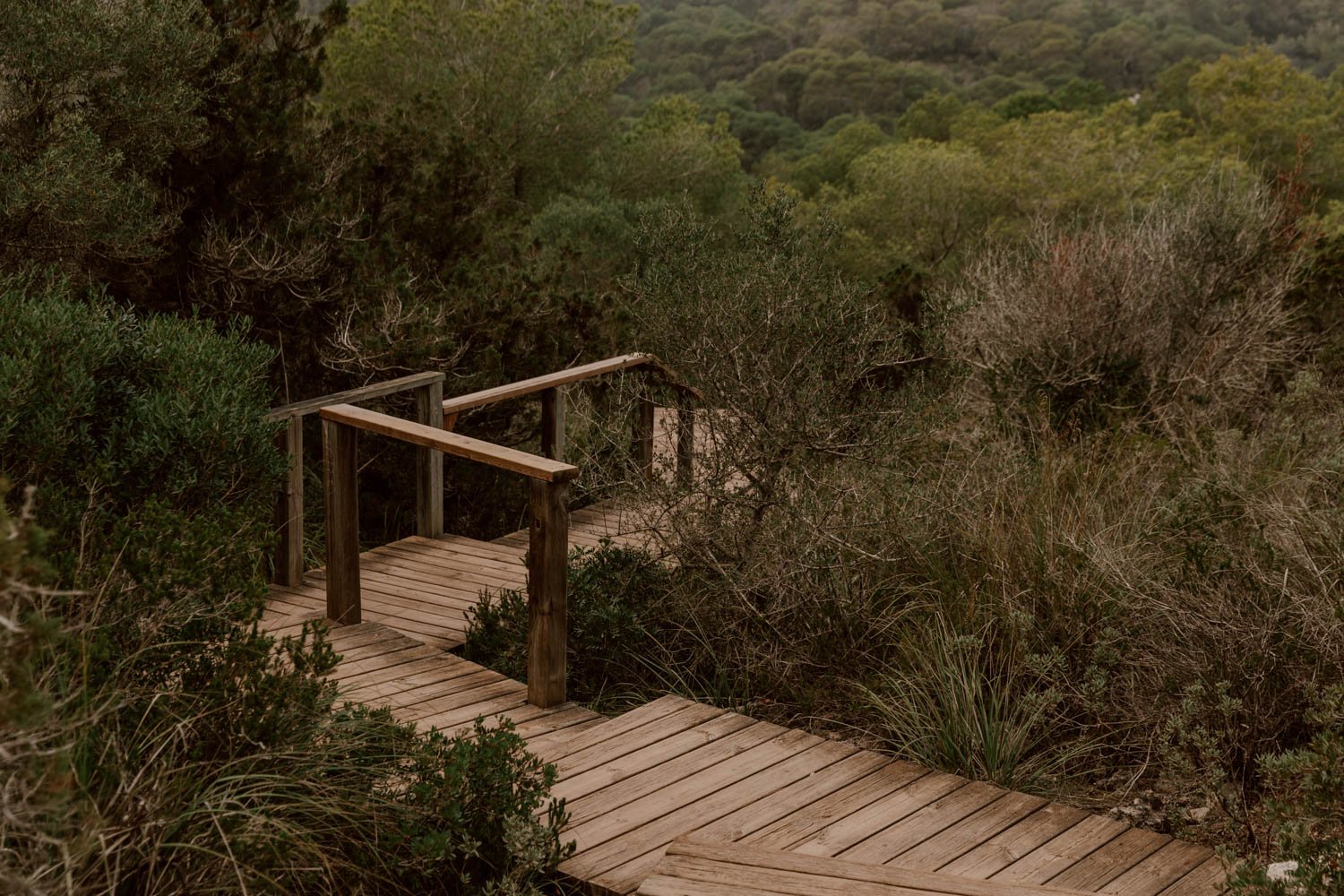Planning on walking the Camí de Cavalls during your time in Menorca? Great idea.
Our essentials guide will get you started on planning your route and experience.
We like to hike, but we also like to have lazy days at the beach.
For some people, that's a travel style combination which may seem to be in conflict; we view it as having the best of both worlds.
If you only like to lie on beautiful beaches, the island of Menorca is a perfect destination.
If you're a hiker, the island of a Menorca is a perfect destination.
If you're like us, the island of a Menorca is a perfect destination (that's why we spent a month there).
A key reason for this broad appeal is the Camí de Cavalls, the dusty 185 km / 115 mile trail which circumnavigates the whole of Menorca. A haven for walkers, it also threads together the coastline for those who wish to access or link the remote and rustic beaches and calas for which the island is famous.
The Camí de Cavalls is therefore both a practical and democratic footpath - equally open to the serious long-distance hiker and the casual short-walk holiday-maker alike - and forms an integral part of everyone's travels in Menorca (except those unadventurous types who never leave their accommodation or the poolside).
If you want to properly explore and appreciate this place, you’ll need to go along this dusty road.
The main distinction is how you choose to experience it, where you choose to experience it, and how much time and effort you're willing to commit to experience it.
That's where our guide comes in.
Based on our experiences of that month in Menorca, plus a previous trip a few years ago, we wanted to clear up any confusion you may have about the Camí de Cavalls and offer a succinct, practical, and personal overview of how best you can factor it into your Menorca holiday plans and the best sections to walk.
For those of you planning a Camí de Cavalls walking holiday or hoping to walk all or much of the 20-section route, this post is also the ideal introduction to the path, helping you to start preparations on the best foot and get a realistic overview to manage your expectations and plan your itinerary.
Alongside essential tips on routes, maps, the kit you need to pack, and responsible travel, we’ve also shared the trusted resources we found most helpful.
These are 7 Things To Know Before Walking the Camí de Cavalls.
The Origins of The Camí de Cavalls
Unlike several more famous long-distance walking paths in Europe, the Camí did not begin as a religious pilgrimage route toward a revered monument or place.
Instead its roots were practical and defensive.
Camí de Cavalls translates as 'Horse Path' or, more poetically, 'The Way of the Horses', and its first official origins are thought to stem from the order of King Jaime II - who reigned over all sorts of places from Mallorca to Valencia, Corsica and Sicily in the 13th & 14th centuries - commanding each of his knights to have a horse ready to defend the island's perimeter.
As Menorca was conquered at various points in preceding and subsequent centuries, this idea was both too late and prescient.
The Spanish, the British, and the French - all of whom held domain over the island at one point from the 1700s - understood the trail’s usefulness to support coastal patrols, connect fortifications, and transport troops or supplies. Due to this, ironically, each invading force played an integral role in maintaining, widening, and codifying the 185 km network of dusty paths.
The first known map of Menorca which includes the Camí de Cavalls is from 1780 by a Frenchman, but local farmers, fishermen, and messengers were undoubtedly as pivotal as any outsider to the creation and formation of these dusty trails linking village to village, beach to beach, and field to field.
It’s also thanks to local community’s efforts that we can continue to walk in their footsteps.
Parts of the path were falling into disrepair or being siphoned offer by private landowners, threatening its integrity and accessibility. Viewing the Camí de Cavalls as as unique piece of Menorcan cultural heritage to be kept whole and protected, the pressure of local groups culminated in the passing of the Llei del Camí de Cavalls (Law of the Camí de Cavalls) by the Balearic Islands in 2000, a law to ensure and enshrine the path’s protection and public access, and kickstart much of the work done to make the route tourist-friendly over the next decade.
In 2012, it attained the distinction of becoming GR 223, part of the European collection of long-distance (GR) trails, meaning that this very old path is a relatively young hiking route.
It's Split Into Twenty Sections
So, what is the Camí de Cavalls today?
Uninterrupted and car-free, the 185 km trail encircles the whole island, including the cities of Mahón, Ciutadella, popular coastal resorts like Cala Galdana and Punta Prima, the lighthouses and the picture-postcard platjas and calas.
It's free and easy to access, open to the public, and well signposted.
The route is segmented into 20 sections, each with a difficulty rating and average time estimate. The shortest is 5.4 km (Section 8 Algaiarens - Cala Morell) and the longest 13.6 km (Section 3 Favàtrix - Arenal d'en Castell).
Travellers are able to walk each and every one independently / self-guided, and you do not require a permit.
You don't have to stick to the specific sections when planning a route, as one bleeds into the other, and some of the best parts to walk as a day trip on the island will incorporate several sections.
At the beginning of each section, there's a large noticeboard with a map of the route and key information on it. Along the path and at regular intervals, there are 2,200+ small wooden stakes (fites), topped with the little white horseshoe plate, as well as distance & direction markers at various points to keep you on the right track.
There’s also the red and white symbol.
How long To walk the whole Camí de Cavalls? Those who you who have done the maths already, may be thinking that there's no way you can walk the whole Camí de Cavalls on your two-week holiday.
And you'd be right.
Sort of.
We reckon you'd need at least nine days to do it all at a realistic pace. A week would be possible if you're not so worried about enjoying the places you pass by and can kick on to cover the distances, whilst two weeks would be the leisurely ideal to include plenty dips in the sea and a rest day or two.
If you do the whole of the route in one-go, please share the experience and your timings in the comments!
All Of You Will Walk It, But You Don't Need To Walk It All
Importantly though, nobody is expecting you to cover all of the Camí on your holiday! Completing it in one fell swoop may be your goal or purpose for visiting the island, but that simply isn't going to be realistic or desirable for many of your reading this post.
And neither should it be!
It isn't like the Cami de Santiago where you really are cheating if you only do the final section. Although the technical start point is in Mahón, this isn’t rigid and you can join it or dip in wherever and however you like.
The use of it to just have a nice coastal walk for the day or a couple of hours, to reach Cala Macaralleta, Cala Mitjana or Cala Pregonda for sunbathing and swimming, to go horse riding, or simply to have a run in the sun, is just as sensible and valid as someone going round the whole thing with hiking poles and boots.
In certain moments and sections, it’ll actually be much better.
Even the hugely unadventurous or unfit will end up on it unwittingly, given that the red-and-white markers take you through resort towns and the two main cities, as well as tourist zone beaches.
So, everyone heading to Menorca will walk upon the Camí de Cavalls at some point! The goal isn’t to complete it, but make the most of it and let enhance your travel experience on the island.
On a personal level, we started research for our month in Menorca assuming that we'd have to dedicate many days to hiking out on the trails, something that appealed but we also had a ceiling on just how much time we wanted to commit to hiking. Thankfully, the more we planned and the more we understood how Menorca is linked up, we came to realise that we'd spend quite a bit of time on the trail as part of our explorations on the south, west, north, and east coasts anyway.
Our final accommodation - this gorgeous little house in Binibeca - was even on the bloody route!
Not All Sections Are The Same
As the name of our travel blog hints at, we like travelling and hiking in remote places where things haven't been developed or sanitised to the Nth degree.
Gloriously, the majority of the Camí de Cavalls is dusty, unpaved, and uneven, and set within nature rather than carved into it.
However, not all sections are the same or offer the same experience.
At points, the trail will carry you along a pavement by a busy road. At others, it takes you inland to the countryside rather than along a breathtaking section of coast. Some sections are ideal for cyclists or horse-riding, whilst others specifically prohibit it. Some will be too difficult or challenging for the unprepared, whilst others can actually be done in flip-flops (not recommended though). Section 20 sees you going through a town and city and alongside a road - not really something to get excited about in comparison to the paradise beaches you'll visit on Section 12 or Section 6. The north is wilder and more barren in stretches, the south peppered with pine forests. A part may be overly busy with beach-goers and daytrippers, others the preserve only of the wind and the intrepid. Some are really short and easy, others longer and a little more challenging.
This is why it's essential to do a bit of research before you set off on a day trip, to cover a bite-sized section, or walk a larger chunk of coastline.
We're not going to share descriptions or an overview of each Camí de Cavalls section in this post though - instead we've shared links to the best resources we used and recommend at the end of the post.
Similarly, we think it makes most sense to view the sections as a guide rather than hard and fast rules - combine them in a way which works for your itinerary or accommodation, transport links available, or allows you to uncover a particular area of the coastline over a day or longer.
Be A Responsible Traveller //
It’s vital that we all respect the trail and nature on the Camí. To support this, make sure you:
· bring out what you take in and leave no trace (i.e. do not litter)
· leave gates as you found them (i.e. if it's open, leave it open; if closed, close it after you pass through).
· stick to the trail, and avoid private paths. Two common signs are ‘Prohibido del Paso’ (no entry), whilst ‘Prohibido del Caza’ means no hunting.
· wild camping is not allowed on the Camí de Cavalls or on beaches in Menorca - see our accommodation section below for more info.
· take the time to prepare adequately for the conditions and know your limits.
· respect your fellow hikers sharing the paths (a nod and an ‘hola’ always goes a long way).
· let someone know your plans if hiking solo.
The Weather Makes A Big Difference
It gets very, very hot in Menorca during summer, which is obviously a big draw to the island; June to September sees average temperatures above 25°C and afternoon highs in the 30s
Great beach weather doesn't equate to great hiking weather though.
That means the best time of year to walk the Camí de Cavalls for longer stretches is in April, May, October and November. Temperatures are cooler, but still in the very pleasant 15-22°C range, all route sections will have less holiday traffic, and accommodation on the island is cheaper. The chance of rain is highest in October and November, and some summer bus routes have ended for the season, but this won’t cause too many issues.
Personally, we would not set out to walk the whole Camí de Cavalls from mid-June to mid-September.
That doesn't mean you should avoid walking the Camí in summer though, either to access a beach or for a day out, but simply adjust your expectations and plan accordingly. Take the heat seriously, respect the trail, and do the following:
1/ Check the forecast and sunrise/set times.
2 / Set off early.
3 / Avoid walking for long periods exposed under the peak afternoon sun.
4/ Carry the essentials, but don't carry anything you won't need.
5/ Hydrate accordingly and take more water than you think you'll need.
6/ Wear a hat and plenty sunscreen, topping up or covering up later in the day.
7/ Be realistic on the route length and your abilities. If you get heat exhaustion or too fatigued on the trail, you'll have no option but to continue until there's a point you can access transport or help, so don't be overly ambitious.
Whether it’s summer or winter, be aware of sunset times and ensure that you’re giving yourself enough time to make it home or to transport before darkness - there are no lights on most of the trail.
We've covered what to pack and wear for the Camí de Cavalls, whatever the season, later in this post.
Transport Connections on / from The Camí
Accessing the Camí de Cavalls may be as simple as walking from your accommodation to join the trail, driving to car park for a quick there + back, or taking a bus to another town / village to a specific section start point.
For the return journey to your accommodation on a day trip hike however, unless you're going to walk back along the same trail section(s), you may have to take two buses. This is due to the limited roads to / from the coast in Menorca, so you will have to bus it to a transport hub like Ciutadella, Ferreries, Es Migjorn Gran, Alaior, or Mahon in order to connect to the bus line which will take you home, so factor this into your route and timings.
Most points on the Cami de Cavalls will not be served by public transport.
Blissfully car-free, the Camí is primarily for walkers. However, certain sections are also open to horses and cyclists if you’d like to experience it in a different way:
Horseback Riding | This 90-minute experience, suitable for beginners and children, involves you experiencing the trail the way it was originally intended. Find out more here.
Cycling | You can rent trail and mountain bikes in Mahón, as well as some of the coastal tourist resorts (i.e. Punta Prima). A few companies to look at for specialist multi-day excursions or rental are Bike Menorca and Cami360. Note that this is a technical ride, and it's worth reading this guy on TripAdvisor honest overview of the cycling experience before firming up anything.
If cycling on the Camí, note that walkers and horses have priority / right of way.
Running | During our month in Menorca, Andrew would often head out for runs along the Camí and there were usually locals doing the same in the early morning or late afternoon. Serious runners may wish to make a note of the Trail Menorca Camí de Cavalls - an ultramarathon which covers the whole Camí over several days in May.
What To Pack + Facilities on The Route
We're big proponents across all our hiking guides - from The Inca Trail in Peru to Ben Nevis in Scotland - that proper footwear is one of the things which will make a walk enjoyable or unbearable. However, we understand that if you've got limited space in your suitcase, and just plan on doing a bite-sized section or a single day of walking, taking up lots of bikini space with unnecessary hiking kit isn't ideal.
Thankfully, if you’re not doing multi-day walks, you do not need to bring big, bulky hiking boots.
Hiking sandals or specific hiking trainers (like these), would be the best option if you’ve got a pair already but, from our experience, you can walk the Camí de Cavalls in trainers. It helps if they’re sports ones with a bit of grip and substance to them, and it shouldn’t be a precious crisp-white pair you plan on wearing with outfits (they’ll get rather dusty).
Although you see lots of people committing this sin, don't wear flip-flops. You will be able to get away with them in certain sections (for example to access Cala Macarella, Cala Mitjana, or Cala Pregonda) or if you're just having a sunset stroll, but it would be silly to set out for any meaningful distance in them or if the section is marked a difficult. There are uneven rocky sections, steep up/downs in parts, and flip-flops ain’t a good choice.
If you're arriving specifically to walk the whole loop or do a multi-day walk, then lightweight and breathable hiking trainers will be ideal. Hiking boots will offer added support and stability, but can be quite uncomfortable when worn with hiking socks for long periods in hot conditions.
Hiking poles are not necessary, but are permitted on the Camí if you're a hiker who prefers them (we use this portable travel set by Brasher, but didn't bring them to Menorca).
Beyond the obivous items, none of you should ever set out on the Camí without swimwear! It is not uncommon to arrive at a gorgeous little cove or swimming hole, or find yourself at a postcard perfect beach full of browning bodies and colourful parasols, and the temptation to strip off and jump in (especially if the heat is up) should be given in to. In summer, it's very common to see nudists sprawled out in one part of the beach and clusters of fully clothed hikers trying to get some shade in another - a very bizarre, very summer in Menorca scene.
If hiking for a few hours or a full day in summer, you will get very very very sweaty, and sunburn is almost inevitable. Don't take your chances though, as it'll just ruin your skin and cause a lot of discomfort for the rest of your Menroca holiday. Slap on the suncream, wear a hat, and bring a spare t-shirt or shirt you can wear to protect any reddening skin on the walk home.
Except for when you pass through a town or city, there are no shops or water points along the trail. Pick up and pack your food the night before, and top up if / when route takes you through or past a shop or restaurant. Water is the most important element to prioritise though, especially if walking 2+kms in summer, and you need to ensure you have enough for the walk back if you won’t be passing anywhere. Unfortunately, this does mean you’ll have to buy and carry single-use plastic bottles of water alongside your filled up reusable ones.
The Best Section of Camí de Cavalls
What's the best part of the Camí de Cavalls? Which section should you prioritise above all others if you can only have one beautiful day of hiking?
It’s an oft-asked question but, unfortunately, the answer will always be purely subjective.
Some will be drawn to the paradise beaches and secluded coves of the south west, whilst others prefer the rugged rust-red remoteness of the northern trails, or those parts taking you through the nature through the Albufera National Park.
We didn't walk each section or do it all in one go, but made judgement calls on the worthiness of some in order to prioritise the many sections and kilometres we did walk. From that and additional research, we think that the following sections will appeal most to you if you’ve only got one day to dedicate to a proper walk on the Camí:
Section 2 | Es Grau - Favaritx / 8.6 km / 3.5 hours / includes Albufera
Section 5 | Cala Tirant - Binimel·là / 9.6 km / 4 hours
Section 6 | Binimel·là - Els Alocs / 8.9 km / 5 hours / includes Cala Pregonda
Section 10 | Punta Nati - Ciutadella / 10.5 km / 4 hours
Section 13 | Cala En Turqueta - Cala Galdana / 6.4 km / 2.5 hours
Section 15 | Sant Tomas - Son Bou / 6.4 km / 2.5 hours
The Litoral path on the south coast, which takes you to several of the best beaches in Menorca is another trail we think is unmissable - a lot of people mistakenly think it's part of the Camí.
Just note that these are popular, and see more people, which may also be a downpoint.
TIPS & RESOURCES
Maps & Route Planners
PDF + Paper Map | Produced by the Menorca tourism office, this clear, user-friendly map has an overview map of the whole 185 km, and also includes an brief but excellent colour-coded overview of each section, with times, difficulty grading, and specific points of interest.
The best option for a snapshot and inspiration for which sections to do.
We picked it up at the airport and highly recommend you do the same (two if you’re going to refer to it a lot). However, you can also view and download a PDF version here.
Route Planner | On the official Camí de Cavalls website, the interface and user-experience is quite clunky, but the level of detail available for each stage is worthwhile if you’re patient with it. Alongside detailed route profiles for each section, you can download everything in a PDF or as a GPX file to your phone.
Accommodation + Camping
As mentioned, wild camping in Menorca is illegal: you cannot camp on the Camí de Cavalls or on the beaches. On many parts of the route, you won’t be close to accommodation (there are not, for example, lots of little hostels, campsites, or huts along the route to cater specifically for walkers).
If you’re doing multi-day walks or trying to complete the whole loop, then you’ll have to plan your route accordingly so you can find a bed for the night on the trail or a short walk off it. In low season, availability shouldn’t be much of an issue, but prices do rocket in summer.
There are a few companies on the island offering logistics support for those planning to do the whole walk in one-go or walk on it for multiple days. This can include transfers to start / end points, transport of your luggage between accommodation, and taking care or organising/booking the accommodation for you; Cami de Cavalls 360° is an established, respected option.
Packing List
This is what you should take if walking in spring, summer, or autumn. If you’re walking during winter, then the emphasis will be on layers, wet weather clothing, appropriate footwear for slippy rocks and mud, and a torch.
/ Hat + Sunglasses
/ Swimwear
/ Towel or Sarong
/ Suncream
/ Clothing to cover and protect skin
/ Reusable water bottle
/ Extra water
/ More water!
/ Lunch + Snacks
/ Cami de Cavalls paper map
/ Fully charged phone (good for maps and route tracking too)
/ Cash for bus tickets
/ Bank card
/ Bus schedule noted
/ Parasol (if going to a beach for the afternoon)
Emergencies | The small wooden stakes are not just to let you know you're on the trail - they're also numbered and the best reference point to quickly share your information in case of injury or an emergency. The emergency number in Menorca is 112.
Where to Next
13 Wonderful Things to Do in Mahon
13 Wonderful Things to Do in Menorca
23 Things to Know Before You Visit Menorca



